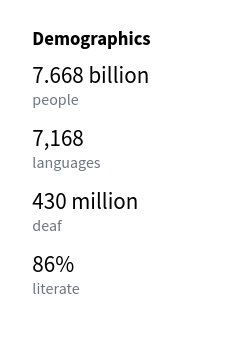Dovrei avere un blog multilingue e come posso iniziare?
Immaginate che il vostro post venga letto a Tokyo, tradotto al volo e che affascini un nuovo pubblico.
Siete incuriositi?
Internet ha ridotto il mondo, rendendo la comunicazione multilingue un gioco da ragazzi. Ma è il caso di fare il grande passo e creare un blog multilingue? Questo post ne analizza i vantaggi e vi guida nell'entusiasmante mondo di raggiungere i lettori oltre confine.
.webp?width=800&height=450&name=Blog_WBM_Platforms%20for%20Engaging%20Your%20Audience%20(1).webp)
Perché i contenuti multilingue sono importanti
-
 Il 61% degli utenti di Internet parla una lingua diversa dall'inglese. Le prime 5 lingue parlate (cinese mandarino, spagnolo, inglese, hindi, arabo) coprono il 43% della popolazione mondiale.Lingue del mondo [Ethnologue Languages of the World].
Il 61% degli utenti di Internet parla una lingua diversa dall'inglese. Le prime 5 lingue parlate (cinese mandarino, spagnolo, inglese, hindi, arabo) coprono il 43% della popolazione mondiale.Lingue del mondo [Ethnologue Languages of the World].
-
Il crescente potere d'acquisto online di un pubblico non anglosassone guida la crescita del commercio elettronico globale. Si prevede che le vendite globali di e-commerce raggiungeranno i 6,4 trilioni di dollari nel 2024, con una crescita significativa nei mercati non anglofoni.[Statista]
-
Traffico dei blog multilingue Aumento dell'audience grazie ai contenuti multilingue. I blog che offrono più lingue possono registrare un aumento del traffico del 47% o più.[Common Sense Advisory].
-
SEO multilingue Impatto quando si raggiunge un pubblico straniero. I siti web con contenuti tradotti si posizionano più in alto nei risultati di ricerca per le lingue desiderate.[bayantech].
Vantaggi di un blog multilingue
Un blog multilingue è uno strumento potente per il marketing digitale e i vantaggi di crearne uno vanno ben oltre l'abbattimento delle barriere linguistiche.
Maggiore visibilità globale
Per quanto riguarda la visibilità online, l'ottimizzazione per i motori di ricerca (SEO) è uno degli elementi più importanti che un'azienda può sfruttare. I contenuti multilingue, integrati strategicamente in un blog, possono avere un impatto profondo sul posizionamento nei motori di ricerca. I motori di ricerca come Google danno priorità ai siti web che soddisfano le diverse preferenze linguistiche. Offrendo contenuti in più lingue, un blog aumenta le possibilità di apparire nei risultati di ricerca pertinenti in un ampio spettro. In questo modo si espande la portata globale del sito e si aumenta la sua visibilità all'interno di ricerche basate su lingue specifiche.
Al di là dei tecnicismi della SEO, un blog multilingue apre le porte a mercati precedentemente non sfruttati e a gruppi demografici diversi. La lingua, in quanto identificatore culturale, ha un significato immenso. Abbracciando più lingue, un blog diventa più accessibile a persone la cui lingua principale potrebbe non essere l'inglese. Questa inclusività amplia la base del pubblico, facilitando le connessioni con individui che altrimenti potrebbero rimanere fuori dalla portata di un approccio monolingue. Si tratta di una mossa strategica per affrontare l'evoluzione demografica del pubblico online, posizionando il blog per la crescita in regioni diverse.
Creare fiducia e credibilità
Le preferenze linguistiche sono profondamente legate alla psicologia individuale e all'identità culturale. Online, gli utenti spesso sentono un legame e una fiducia più forti nei confronti dei contenuti presentati nella loro lingua madre. La comprensione di questo aspetto psicologico è fondamentale per i marchi e le aziende che mirano a stabilire una presenza globale online. Un blog multilingue sfrutta questa preferenza innata riconoscendo e rispettando la diversità linguistica, gettando le basi per la fiducia di un pubblico eterogeneo.
La fiducia è la chiave di volta delle interazioni online di successo, soprattutto quando si naviga nei mercati internazionali. Un blog multilingue comunica un impegno all'inclusione e alla consapevolezza culturale. Il blog dimostra un interesse genuino nel comprendere e soddisfare le loro esigenze, fornendo contenuti nella lingua del pubblico. Questo sforzo concertato favorisce un senso di credibilità, che risuona con il pubblico internazionale e coltiva la fiducia nel marchio o nell'azienda. Con l'aumentare della fiducia, aumenta anche la probabilità di convertire i visitatori in clienti fedeli, con un impatto sul successo complessivo del blog.
Maggiore coinvolgimento ed esperienza utente (UX)
Il coinvolgimento degli utenti è strettamente legato alla pertinenza e all'accessibilità dei contenuti. Per le persone che non parlano inglese, un blog multilingue offre contenuti personalizzati e relazionabili, in linea con le loro sfumature culturali. Questo livello di personalizzazione aumenta il coinvolgimento degli utenti, offrendo un'esperienza più significativa e risonante. I visitatori sono più propensi a trascorrere del tempo su un sito che parla la loro lingua, approfondendo contenuti che rispondono ai loro interessi, preoccupazioni e aspirazioni.
Un'esperienza utente senza soluzione di continuità è un'aspirazione universale per qualsiasi piattaforma online. Nel contesto di un blog multilingue, ciò riguarda la qualità dei contenuti e la facilità con cui gli utenti possono navigare tra le diverse opzioni linguistiche. L'implementazione di funzioni intuitive di cambio lingua garantisce ai visitatori di accedere senza sforzo ai contenuti nella loro lingua preferita. Questo impegno per una navigazione facile contribuisce a creare un'esperienza complessiva positiva, incoraggiando visite prolungate e un impegno ripetuto.
Miti comuni sui blog multilingue
Sono costosi e complessi
Un luogo comune che circonda i blog multilingue è la percezione della complessità e dei costi esorbitanti associati alla loro implementazione. Se è vero che la gestione dei contenuti in più lingue richiede un approccio strategico, i progressi della tecnologia hanno semplificato il processo.
Sono disponibili numerosi plugin e strumenti di traduzione di facile utilizzo, che semplificano il flusso di lavoro di traduzione. Contrariamente all'idea sbagliata dei costi iniziali, l'investimento in un blog multilingue può essere visto come una mossa strategica per sbloccare nuovi mercati, con un ritorno positivo sull'investimento.
L'inglese è sufficiente
Alcuni potrebbero pensare che l'inglese, in quanto lingua globale ampiamente parlata, sia sufficiente per raggiungere un pubblico online diversificato. Tuttavia, questo mito trascura la diversità linguistica e le preferenze degli utenti di Internet in tutto il mondo. Una parte significativa della popolazione mondiale comunica principalmente in lingue diverse dall'inglese. Le aziende rischiano di allontanare un vasto pubblico limitando i contenuti a una sola lingua.
L'adozione di un approccio multilingue dimostra un impegno verso l'inclusività e risuona con gli individui che preferiscono consumare i contenuti nella loro lingua madre, ampliando così la portata del blog.
Qualità dei contenuti e problemi di traduzione
La qualità e l'accuratezza della traduzione sono preoccupazioni fondamentali per le aziende che prendono in considerazione un blog multilingue. I timori per la potenziale perdita di significato o di sfumature culturali nella traduzione possono scoraggiare alcuni dall'avventurarsi nella creazione di contenuti multilingue. Tuttavia, queste preoccupazioni possono essere affrontate efficacemente con servizi di traduzione professionali e un attento lavoro di localizzazione.
Collaborando con traduttori esperti che comprendono le complessità della lingua e della cultura, le aziende possono mantenere l'integrità dei loro contenuti in tutte le lingue, garantendo un'esperienza utente coerente e di alta qualità.
Passi pratici per il lancio di un blog multilingue
1. Valutare il pubblico di riferimento
Prima di tuffarsi nella creazione di contenuti multilingue, è fondamentale conoscere la diversità linguistica del vostro pubblico di riferimento. Analizzate i dati demografici dei vostri lettori attuali e potenziali per identificare le lingue prevalenti. Questa comprensione costituisce la base per adattare i contenuti alle preferenze linguistiche del vostro pubblico.
Sfruttate l'analisi del sito web per raccogliere dati sulle lingue parlate dal vostro pubblico attuale. Piattaforme come Google Analytics e Semrush forniscono informazioni specifiche sulle lingue, aiutandovi a identificare le regioni con un significativo coinvolgimento degli utenti. Questo approccio basato sui dati consente di prendere decisioni informate quando si selezionano le lingue per il blog multilingue, assicurando che i vostri sforzi siano in linea con le preferenze del pubblico esistente.
2. Scegliere le lingue giuste
Sebbene l'obiettivo sia quello di raggiungere un pubblico globale, le considerazioni pratiche sono fondamentali nella scelta delle lingue per il vostro blog multilingue. Considerate le regioni in cui i vostri prodotti o servizi sono richiesti e date la priorità alle lingue di conseguenza. Trovare un equilibrio tra portata globale e fattibilità garantisce un approccio mirato che massimizza l'impatto dei vostri contenuti multilingue.
Conducete una ricerca di mercato approfondita per identificare le lingue che risuonano con il vostro target demografico. Valutate il panorama competitivo nelle diverse regioni e identificate le lingue comunemente parlate o con una crescente presenza online. Questo approccio basato sui dati garantisce che il vostro blog multilingue sia in linea con le tendenze del mercato, ottimizzando le possibilità di catturare l'attenzione del vostro pubblico.
3. Implementare funzioni di commutazione della lingua di facile utilizzo
Rendete la transizione linguistica perfetta per i vostri visitatori implementando funzioni di cambio lingua di facile utilizzo. Per i sistemi di gestione dei contenuti più diffusi, come HubSpot o WordPress, sono disponibili numerosi plugin e strumenti che rendono facile l'integrazione di funzionalità multilingue. Ne sono un esempio WPML (WordPress Multilingual) e Polylang. Questi strumenti consentono agli utenti di passare da una lingua all'altra, migliorando senza sforzo l'esperienza complessiva dell'utente.
L'esperienza utente è fondamentale in un blog multilingue. Assicuratevi che le funzioni di cambio lingua siano intuitive e facilmente accessibili. Etichettate chiaramente le opzioni linguistiche e prendete in considerazione la possibilità di incorporare bandiere o icone per una maggiore chiarezza visiva. Testate la funzionalità su tutti i dispositivi per garantire ai visitatori un'esperienza di navigazione senza interruzioni, indipendentemente dalla lingua scelta.
4. Creare traduzioni di alta qualità
Mantenere l'integrità e l'accuratezza dei contenuti nelle varie lingue è fondamentale per il successo di un blog multilingue e di un buon contenuto. Investite in servizi di traduzione professionali per garantire che sfumature, riferimenti culturali e messaggi siano trasmessi con precisione. Traduttori professionisti esperti nel vostro settore e nelle lingue di destinazione possono elevare la qualità dei vostri contenuti, favorendo la fiducia e la risonanza con pubblici diversi.
Lavorate a stretto contatto con i traduttori per trasmettere il tono e lo stile specifici del vostro marchio in ogni lingua. Fornite guide di stile complete e un contesto che aiuti i traduttori a comprendere le sfumature dei vostri contenuti. Una comunicazione regolare con il team di traduttori è fondamentale per rispondere alle domande e garantire una voce coerente in tutte le lingue. Inoltre, eseguite controlli di qualità approfonditi per individuare le discrepanze e perfezionare il processo di traduzione nel tempo.
5. Considerazioni SEO per ogni lingua
Un SEO efficace in un blog multilingue si basa sulla personalizzazione meticolosa delle parole chiave e dei meta tag per ogni lingua. Comprendete le sfumature linguistiche e le variazioni nelle query di ricerca nelle diverse regioni. Conducete una ricerca sulle parole chiave in ogni lingua di destinazione per identificare i termini e le frasi che risuonano con il pubblico locale. La personalizzazione dei meta tag, compresi i titoli e le descrizioni, assicura che i motori di ricerca indicizzino e visualizzino accuratamente i vostri contenuti, ottimizzando la visibilità per gli utenti che effettuano ricerche in lingue diverse.
Oltre all'ottimizzazione delle parole chiave, l'implementazione di strategie SEO localizzate è essenziale per massimizzare l'impatto di un blog multilingue. Ciò comporta la creazione di contenuti specifici per ogni regione, che rispondano alle esigenze e agli interessi unici di ciascun pubblico target. Adattate i vostri contenuti in modo da riflettere le sfumature culturali, le tendenze e le preferenze, dimostrando una reale comprensione dei contesti locali. Inoltre, ottimizzate la struttura del vostro sito web per le diverse regioni, incorporando i tag hreflang per segnalare ai motori di ricerca quali versioni linguistiche sono destinate a un pubblico specifico.
Includere le migliori pratiche SEO multilingue
- Trattate ogni lingua separatamente; solo perché una parola chiave funziona in una lingua non significa che funzioni anche in un'altra.
-
Seguite le best practice di Google per la gestione delle pagine multilingue, in modo che nelle SERP venga visualizzata la pagina più appropriata. Utilizzate i tag hreflang e definite una lingua principale per il vostro sito.
-
Non fate "cross-link tra le lingue", il collegamento a dettagli di contenuto in una lingua straniera è spesso una sorpresa (negativa) per i lettori che non si aspettano o non capiscono quella lingua. Creare cluster di argomenti e link interni in una sola lingua.
-
Non date per scontato che un utente possa o voglia usare Google Translate per interagire con i vostri contenuti.
-
Se non potete offrire il vostro servizio nella lingua del vostro sito web, deluderete i vostri visitatori a un certo punto del viaggio.
-
Consentite un facile cambio di lingua (manuale), non date per scontato che solo perché l'indirizzo IP di qualcuno si trova a Stoccolma, voglia vedere i vostri contenuti in svedese.....
Liberate il potenziale globale con un blog multilingue
La decisione di adottare un blog multilingue è un salto strategico verso una presenza online più inclusiva e di risonanza globale. Comprendendo la diversità linguistica del vostro pubblico, selezionando le lingue giuste, implementando funzioni di commutazione linguistica senza soluzione di continuità e dando priorità a traduzioni di alta qualità, le aziende possono superare le barriere linguistiche e attingere a mercati inesplorati.
Con la continua evoluzione del panorama digitale, un blog multilingue allarga gli orizzonti e posiziona le aziende come culturalmente consapevoli e impegnate a soddisfare le diverse esigenze di un mondo interconnesso. Non si tratta semplicemente di parlare lingue diverse, ma di creare una conversazione universale che risuoni oltre i confini e favorisca connessioni durature.
Questo contenuto è disponibile in:
- Tedesco: Soll ich einen mehrsprachigen Blog betreiben und wie fange ich an?
- Inglese: Should I Have a Multilingual Blog, and How Do I Get Started?
- Spagnolo: ¿Blog multilingüe? ¿Sí o no? ¿Cómo empezar?
- Francese: Faut-il créer un blog multilingue et comment démarrer?
- Rumeno: Ar trebui să am un blog multilingv și cum să încep?
- Cinese: 我应该开一个多语言博客吗?如何开始?

Joachim, formatore certificato HubSpot con oltre 13 anni di esperienza in Content Marketing, Strategia, implementazione di siti web e SEO, ha realizzato numerosi progetti di growth marketing internazionali su larga scala, ad esempio con UiPath, dallo status di startup fino alla quotazione in borsa (IPO) al NYSE. Joachim ha una competenza particolare in progetti multilingua di Marketing e Sales Enablement, sfruttando per i nostri clienti le più avanzate tecnologie di intelligenza artificiale (IA).









Facci sapere cosa ne pensi.